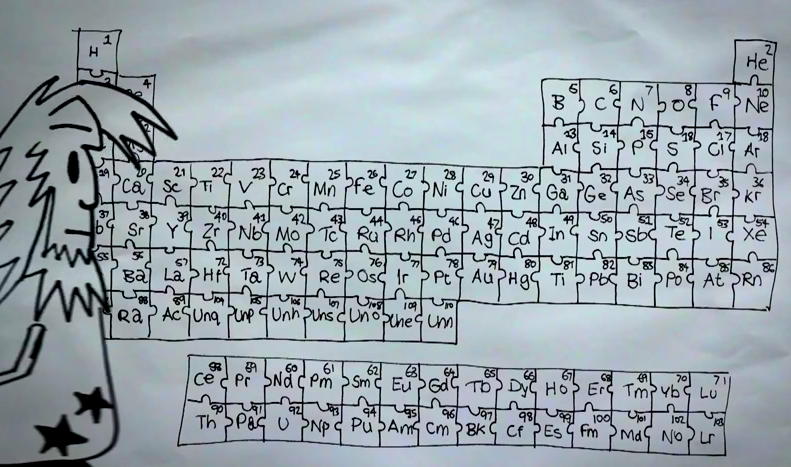(单词翻译:单击)
Our Earth is a collection of puzzle pieces that make up the universe.
我们的地球是组成宇宙的拼图的集合。
In the vast darkness of space, the universe is lit by stars,
茫茫黑暗的宇宙被繁星照亮,
which could one day become a supernova and create all the puzzle pieces that we know today as the elements.
这些星星或许有一天能够变成一个超新星,然后创造出我们现在所知的拼图:元素。
All elements were formed and released into space by exploding stars.
所有的元素都由爆炸的恒星形成并释放到宇宙中。
For centuries, humans have tried to discover what makes up the world around them.
几个世纪以来,人类一直尝试发现他们身边的世界是由什么组成的。
Little did they know that all the pieces they needed were right under their noses.
他们不知道的是他们所有需要的零件就在他们眼前。
The discovery of these pieces revolutionized our understanding of the world
这些零件的发现彻底颠覆了对这个世界的认识,
and allowed for the creation of what might be the greatest gift to science: the periodic table.
并且促成了一个或许对科学最伟大的贡献的创造:元素周期表。
So, where are these elements, and how do we find a means to order them?
那么,这些元素到底在哪儿呢?我们又如何去排列它们呢?
Well, believe it or not, ancient civilizations were very much aware of many elements around them,
不管你信不信,古代文明已经认识到他们身边的许多元素的存在,
but they did not identify them as the pieces of our universe.
但是他们还不知道这些元素是宇宙的组成部分。
Elements like gold, silver, and copper were easily spotted by ancient cultures,
像金,银,铜这样的元素,很容易就被古文化人辨别出来,
and were used for multiple purposes like jewelry and tools.
并且有多重用途,比如制作首饰和工具。
Why were these elements spotted so easily?
为什么这些元素很容易被识别呢?
Think of the periodic table as a puzzle.
把元素周期表想做一个拼图。
The corner pieces are edges of a puzzle, are generally the easiest to find and place
边角上的拼图块是拼图的边缘,通常这些是最容易被找到和定位的,
because they stand out with their smooth edges, and clearly don't interlock with other puzzle pieces.
因为他们平滑的边缘使它们与众不同,而且很明显它们不与其它的拼图块有交接。
Like puzzle pieces, elements can be choosy on who they interact with.
像拼图一样,元素对它们和谁发生互动很挑剔。
Some like to react with other elements, while others do not.
有些喜欢和别的元素发生反应,而有些不会。
The elements that do not interact with other elements are easy to pin-point,
那些不容易和别的元素发生反应的元素很容易被定位,
while the ones who like to interact with others are difficult to find.
而那些很容易和别的元素发生反应的元素很难被发现。
Gold, silver, and copper are some of the choosier elements so we can find them easier.
金,银和铜是一些比较挑剔的元素,所以找到它们更加容易一些。
So let's fast forward to the late 1600's where Hennig Brand, a German alchemist, was busy working in his laboratory.
让我们快进到17世纪末,亨尼格·布兰德,一个德国的炼金术士,在他的实验室里忙碌着。
Like many other alchemists of his time, Brand was trying to extract gold from the human body.
像许多与他同一时代的炼金术士一样,布兰德正试图从人体中提取出金。
Brand hit upon what he thought was the most obvious answer to his problem: urine.
布兰德偶然发现了他认为这个问题最简单的答案:尿液。
Urine is gold in coloration and could perhaps have gold in it.
尿液的颜色与金相似,所以或许金就在里面。
So, Brand collected as much urine as he possibly could, much of it being his own,
于是,布兰德收集了许多尿液,大部分是他自己的,
then he decided to boil it down in hopes of obtaining gold.
然后他决定把它煮光,希望里面有金。

So Brand boiled his, well, urine, down until he collected a paste and heated the paste to a very high temperature.
于是布兰德开始煮他的,额,尿液,直到形成了糊状,然后将糊状物高温加热。
Eventually smoke appeared and the material burned brightly and violently.
到最后产生了烟,然后那种物质开始剧烈燃烧。
Brand had unknowingly isolated phosphorous from his urine.
布兰德无意间从他的尿液中分离出了磷。
It was the first time anyone had discovered an element, but he didn't really understand what he had done.
这是有史以来第一次有人类发现一种元素,但是他不明白他发现了什么。
At the time of Brand, the concept of element had not been discovered.
因为在布兰德的时代,人们还没有元素的概念。
Instead ancient Greek principles of objects being composed of earth, water, air, and fire were predominant.
古希腊人认为所有的物体都有四中元素组成:土,水,气和火,这些元素占主要地位。
It wasn't until the work of Antoine Lavoisier,
直到安托万·拉瓦锡,
who is now known as the father of chemistry, that science defined what an element was.
这位现在被称为化学之父的科学家的研究工作,才使科学界懂得什么是元素。
Lavoisier defined an element as a substance that cannot be broken down by existing chemical means.
拉瓦锡定义元素为一个不能被化学反应再分解的物质。
Lavoisier created a list of the known elements of his time
拉瓦锡创造了一个他已知元素的清单,
and tried to put the elements in some sort of order in which they could be classified, such as gases or metals.
然后试着把它们按照某种规律排列归类,比如气体和金属。
He was the first one to try to put the puzzle together.
他是第一个尝试把这个拼图组合起来的人。
This was just the beginning of a means to organize the known elements of his time.
这只是一系列组织当时的已知元素的不同方法的开始。
Many other chemists then came along to make the puzzle clearer.
许多别的化学家继续想使这个拼图变得更加清晰一些。
One of them, John Dalton, weighed the elements and arranged the puzzle by weight.
其中一个化学家,约翰·道尔顿,称量了所有的元素,然后按重量将元素排序。
German chemist Wolfgang Dobereiner later combined elements to see how they reacted with one another.
德国化学家沃尔夫冈·德贝莱纳之后按照元素之间如何产生反应的规律将元素组合。
What he found was that certain elements shared similar properties and reactions.
他发现有些元素和其他元素有相似的性质和反应。
For example, when pure lithium, sodium, and potassium are exposed to water,
比如说,当纯锂,钠和钾接触水时,
they will react violently and skid across the surface of the water with sparks.
就会产生剧烈反应,并且会在水面上滑动产生火花。
The scientists then realized that these similiarities are no coincidence:
科学家们然后意识到这些相似之处并不是巧合:
elements belong to families that share similar properties.
同族的元素有相似的性质。
But the chemist who finally put the puzzle together is Dmitri Mendeleev.
但是最终把拼图拼在一块儿的是德米特里·门捷列夫。
He created cards of each known element and tried to order them based on atomic weight and their known properties.
他给每一个已知的元素做一张卡片,然后试着根据它们的原子量和性质排列元素。
The story is that he stayed up 3 days and 3 nights, and he finally fell into a deep sleep
据说他三天三夜没睡觉,最后他终于睡着了,
and he dreamed about a table to order the elements.
然后梦到了一张排列元素的表。
Mendeleev was not only able to create the periodic table, but he was able to predict elements that were not yet discovered.
门捷列夫不仅创造了元素周期表,他还能够预测一些当时还未被发现的元素。
The puzzle of the periodic table of the elements was solved.
元素周期表之谜就此解开了。


